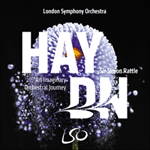Symphony No 6 begins with a brief Adagio introduction that is undoubtedly meant to represent a sunrise (a foretaste, perhaps, of the similar passage in
The Creation). The ensuing Allegro immediately introduces the flute and oboes as soloists, but the slow movement takes on the guise of a miniature concerto for the violinist Tomasini and cellist Weigl—a concertante group accompanied by a ripieno body of strings—a deliberate throwback to the Italian Baroque—even the ideas recall the musical gestures of Corelli. More unusually, the trio to the Minuet features a duet for violone (double bass) and bassoon. The finale returns to the concerto grosso layout with concertante violin and cello and features a virtuosic display for the former at its centre.
from notes by Matthew Rye © 1991
La Symphonie nº 6 commence par une brève introduction Adagio indubitablement conçue pour représenter un lever de soleil (un avant-goût, peut-être, du passage analogue de
La Création). L’Allegro qui suit introduit immédiatement la flûte et les hautbois comme solistes, mais le mouvement lent prend la forme d’un concerto miniature pour le violoniste Tomasini et le violoncelliste Weigl, groupe concertant accompagné par un ripieno de cordes: il s’agit là d’un retour délibéré au baroque italien—même les idées rappellent le style de Corelli. De façon plus inhabituelle, le trio du Menuet offre un duo pour violone (contrebasse) et basson. Le finale revient au schéma du concerto grosso avec violon et violoncelle concertants, et a pour centre une démonstration de virtuosité pour le premier instrument.
extrait des notes rédigées par Matthew Rye © 1991
Français: Elisabeth Rhodes
Haydn hielt sich insofern nicht an Vivaldis Vorbild, als er keinem detaillierten Programm außermusikalischer Ereignisse folgte, aber die Nr. 6 beginnt immerhin mit einer kurzen Adagio-Introduktion, die zweifellos den Sonnenaufgang darstellen soll (Vorgeschmack vielleicht auf die ähnliche Passage der
Schöpfung). Das anschließende Allegro führt sogleich Flöte und Oboen als Soloinstrumente ein, während der langsame Satz in Gestalt eines Miniaturkonzerts für den Violinisten Tomasini und den Cellisten Weigl daherkommt—eine Concertino-Gruppe, die von einem Streicher-Ripieno begleitet wird. Dies ist ein bewußter Rückgriff auf das italienische Barock—selbst die Motive erinnern an die musikalischen Gesten Corellis. Noch ungewöhnlicher ist das Duett für Violone (Kontrabaß) und Fagott, das im Trio des Menuetts vorkommt. Das Finale kehrt mit konzertierenden Violine und Cello zur Struktur des Concerto grosso zurück und zeichnet sich im Mittelteil durch eine virtuose Violinpassage aus.
aus dem Begleittext von Matthew Rye © 1991
Deutsch: Anne Steeb/Bernd Müller


 Haydn: An Imaginary Orchestral Journey
Haydn: An Imaginary Orchestral Journey
